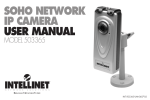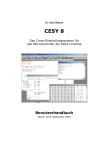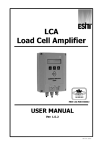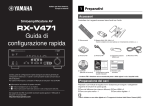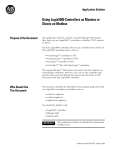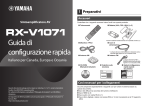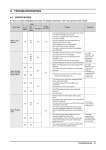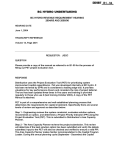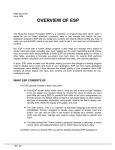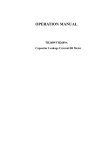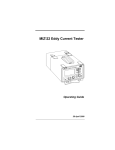Download pwi-en user manual
Transcript
PWI Series Indicators User Manual PWI Series Indicators User Manual ! IMPORTANT NOTICE! In case the indicator you are using is a part of a scale system that is used for trade, it should be protected with an official seal and be controlled every two years. Contents Intruduction Specifications Technical Specifications Operation Specifications Display Specifications Control Specifications (Option) Physical Dimensions Apperance Displays Keys Assembling the PWI Indicator Safety Precautions Basic Flow of the PWI Indicator Parameters Loadcell Test (LCTEST) Parameter Entry (SETUP) Digital Filter Decimal Point Scale Type CAP-E2 (Max. Allowable Weight) 1 3 3 4 5 5 7 11 11 14 15 17 18 20 20 21 21 23 24 25 e2 (Weighing Steps Display Resolution) CAP-1 (First Interval) e1 (Weighing Steps Display Resolution) DRIFT (Zero Drift Correction) Communication Adressed Commmunication Communication Speed Bit Parity Weight Calibration Gain Adjustment Zero Calibration Load Calibration Option Digital Output Relay output (OUT-0 Binary / BCD Output BCD Output (OUT-1) Binary Output (2's complement) (OUT-2) Analog Output Adjustment Of Analog Output DAC Mode Analog Output Adjustment (DACCAL) 26 27 28 29 31 36 37 38 39 40 42 43 44 46 46 48 50 52 53 55 55 56 58 PWI Program Selection Weight Measurement Resetting Display Value To Zero Activating Tare Showing Tare Value Disabling Tare Value Level Control Transmitting Weight Value From Serial Line PWI Peak-Hold Indicator Program PWI Bag Filling Program PWI Batch Controller Program Power Supply Controller Program Operating Temperature Cable Connections Loadcell Connection Communication Cables Error Codes 64 65 65 66 66 67 67 71 71 76 80 86 86 87 88 90 91 User Manual Intruduction PWI Indicator is designed for fast, accurate and high sensitive weight, force and pressure indication. The indicator can be used with every kind of resistive bridge sensors. The indicator was designed for industrial applications and standard weight measurement fields. The communication with commonly used PLC's has been taken into account, where they are widely used almost in all the automation systems. Besides the computer and PLC communication features, the indicator is also suitable for tank weighing, platform scales and batching systems. PWI possesses custom designed Liquid Crystal Display for easy operator dialogue. With the red light LED option of the display, weight can easily be seen even in the dark environment. The special characters on the display enables the user to be familiar with the keypad and universal weight and measure icons. The analogue bar graph makes the weight to be easily understandable by showing the weight in percentage of the full scale. It possesses a water and dust proof membrane keypad. All calibration values can be set via this keypad (calibration, span adjustment, communication mode, parameters, etc.). Designed with SMD technology. Page 1 PWI Series Indicators Available Outputs Relay Output 4 In / 8 Output Analog Output Voltage Output (0-10 V) Current Output (0-20 mA) BCD / BIN 1+18 bit Output Serial Data Out 1200bps, 2400bps 4800bps,9600bps Page 2 User Manual Specifications Technical Specifications Easily achieved menu steps Parameter and calibration changes easily done via keypad Connectable upto ±10 mV/V input (±100 mV) Sense-Gain adjustment according to sensor output Tare function enabling zeroing within whole weighing range 250mA at 10 VDC loadcell excitation voltage 90/384 EEC EURO directives and CE approved Test of all functions during power up Page 3 PWI Series Indicators Operating Specifications Following functions can be fulfilled via keypad Calibration Gain adjustment Communication format and speed Digital signal filter Taring Displaying tare Zeroing Displaying excitation and output signals of the sensor No-motion detection Center of zero detection (1/4 d) Warning above maximum allowable weight Page 4 User Manual Display Specifications Specially designed wide viewing-angle LCD or LED display Analogue bar-graph (LCD display) 7 digital output symbol 2 digital input symbol Tare indication Center-of-zero symbol No-motion detection symbol Up-down and equal symbols (LCD display) Showing weight with decimal point (236.910 kg) Control Specifications (Options) 18+1 Bit BCD or Binary 0-10 V or 4-20 mA analogue output Control. Formed of 8 outputs, 4 inputs Page 5 PWI Series Indicators Input A/D speed (/second) Display sensitivity Display Maximum range Communication Loadcell excitation Input voltage Weighing accuracy Additional specifications EMC Page 6 : DC: -100.00 ,+ 100.00 mV : 50 :1/100.000 : LCD or 7-segment LED : 6 digit (-199999 +999999) : RS-232C/RS-485/RS-422 : 250 mA @10 VDC (8 Load cells) : 12-24 V DC or AC : 3000d or 5000d class III model : Special software available : EN 55011:1991 Emission - Class A EN 45501:1992 Metrological aspects of non-automatic weighing instruments EN 50082:1995 Generic immunity standard, from which: EN 61000-4-2:1995 Electrostatic discharge (ESD) immunity ENV 50204:1995 Digital radio telephones immunity EN 61000-4-4:1995 Electrical Fast Transient (EFT) immunity EN 61000-4-6:1996 Conducted Radio-Frequency disturbances immunity User Manual Physical Dimensions PWI-P (Panel Type) 74 65.7 145.8 8.3 136 142.5 142.5 Dimension-Cut Out:137.5x67.5mm Page 7 PWI Series Indicators PWI-D (Desk Type) - PWI-C (Column Type) 145.8 56 142.8 145.8 214 35 56 214 142.8 Page 8 35 User Manual PWI-S (Stainless Steel Type) 170 200 245 200 28 222.5 110 PWI-E (Ex-proof Type) 143 98 10 320 35 237 Page 9 PWI Series Indicators PWI-T / X (Weighing Terminal) 87 60 55 344 359 349 Page 10 92 244 User Manual Apperance LCD Display 1 2 Up 3 EQ PWI SP3 SP4 SP5 SP6 SP7 IN1 IN2 0 5 Dn 4 7 SP2 SP1 TT % kg9 6 5 8 10 15 20 25 30 35 40 45 50 55 60 65 70 75 80 85 90 95 10 TEST 11 1- Tare 2- Up 3- Equal 4- Down 5- Center of Zero 6- No Motion 0 T T SP 12 13 14 15 7- Set-Point 8- Inputs 9- Kg 10- Analog Bargraph 11- Test 12- Zeroing 16 13- Tare 14- Tare Show 15- Set-Point 16- Print Page 11 PWI Series Indicators Annuciators T Tare : Lights when TARE is active. Blinks when showing the TARE weight. No motion indication: Lights when there is no motion and goes off when there is movement on the platform. Center of zero: Lights when displayed weight is zero and the internal count is less than 1/4d (d: The internal count which can increase the display by 1 step value). Scale Type LED Display 8.8.8.8.8.8. kg ZERO 1 2 1- Zero: Center of Zero 2- e1: 1. Step 3- e2: 2. Step Page 12 e1 e2 3 max 4 P2 TARE 5 NO MOTION 6 4- Max: Max. Load 5-Tare 6- No Motion User Manual Standard Panel Type LED Display 8.8.8.8.8.8. kg SP1 SP2 1 SP3 SP4 P2 TARE 2 NO MOTION 3 1- 4 Outputs 2- Tare 3- No Motion Page 13 PWI Series Indicators Keys Test Key: Tests all functions. Device acts as if first powered-up. 0 Zeroise Key: Makes screen value 0 (zero) if within allowable limits. Tare Key: Used to set value as TARE or disable the previous tare value. Works as toggle uses as MOVE CURSOR in parameter entires. Show Tare Key: Displays tare value when TARE is active, used as INCREMENT in setup mode. Set-Point Key: Used for entering menus for set-up and calibration. Print Key: Transmits the serial data of the weight value from the serial out. In setup mode used as ENTER. Page 14 User Manual Assembling The PWI Indicator 2 1 3 4 5 1- Analog output 15'd female 2- Digital output 25'd male 3- LC connector 9'd female 4- Communication connector 9'd male 5- Power connector The indicator is taken out from its protecting case. The Loadcell cable and Serial communication cables are connected to Loadcell connector and serial communication connector respectively. If the PWI indicator will not be connected to an external device (PC, PLC) then serial output connector is left unplugged. The power supply given together with the indicator or a similar which fulfills the power conditions is connected to the power connector. Page 15 PWI Series Indicators When energy is applied from the power connector, the device starts working with the TEST procedure ( Page: 18). Since analog output, 0(4)-20mA or 0-10V; digital output are optional, they do not exist on a standard device. The user must state the necessary options before demanding the device. The user needs an external power supply of 18-24 VDC for 0(4)-20 mA or 0-10 V analog output option. If cable connections will be done by your side see Page: 88 for connections. Page 16 User Manual Safety Precautions Always use the power supply given together with the indicator or a similar one with specifications given in (Page: 86). TES T Never press the keys with sharp or cutting edged materials. Take care that load cell or power cables do not pass near power or transmission lines. Keep cables away from bruises. Take care of the operating temperature ( Page: 86). After all connections are completed, apply energy to the indicator. Never make changes in connections when power is on. Page 17 PWI Series Indicators Basic Flow of PWI Indicator When power is first applied or TEST key is pressed, all segments of display are lit. Before normal weighing display, by pressing the setpoint key SET-UP and CALIBRATION routines can be executed. ? ? .3 >>> SET-UP Power-up screens are as follows: ? ? ? kg ? WEIGHING Page 18 VER-4.3: Number of the software version PROGRAM TYPE STNDRD: Standard PWI-T: Truck Scale FILLNG: Filling-Batching DOSAGE:Dosage Batching HOLD:Peak and Hold AXLE: Static/Dynamic axle scale ESIT: Manufacturer company CHECK-SUM Program control code CAPACITY: Maximum allowable weight User Manual The value of the analog input and is displayed (Page:18) Digital filter, Decimal point, Capacity, Weighing Step parameters are displayed (Page:21) Serial communication parameters are displayed (baudrate, bit, parity) (Page:31) Span and real weight Calibration (Page:41) Relay or BCD/BIN option parameters selection (Page:46) Adjustment of Analog Output (Page:55) Page 19 PWI Series Indicators Parameters After power is first applied or TEST key is pressed, by simply pressing the SET-POINT key , the PARAMETER menus can be executed. These menus are formed in six main groups: LCTEST, SETUP, COMM, CALIBR, OPTION and DACCAL. Load Cell Test Within this menu, the value of the analog input is displayed. The millivolt calibration of the indicator is factory set and cannot be changed later. The maximum input range of the analog input is ±100mV (±10mV/V). In order to enter this routine PRINT key is pressed. To switch to the next menu, SETUP, SHOW-TARE key is pressed. When LCTEST menu is entered, on the right hand side of the screen appears. kg IN1 SP1 To exit the menu TEST Page 20 key is pressed. SP2 SP3 SP4 P2 TARE NO MOTION User Manual Parameter Entry (Setup) In this menu, Digital Filter, Decimal Point, Weighing Capacity, Weighing Steps and Drift parameters are displayed and can be changed. In order to enter this routine, PRINT key is pressed. To switch to next menu (COMM) SHOW TARE key is pressed. The mechanical vibration and electrical noise can be filtered out by this parameter The decimal point used when displaying the weight MULRNG,MULINT SINGLE Maximum allowable weighing range The weighing resolution First weighing range value Weighing resolution until first weighing range Zero drift correction 0: Tare disabled. 1: Pushbutton Tare Page 21 PWI Series Indicators FILTER MODE: FILTR.0 : Speedy measurement. (Recommended for Hold Programme) FILTR.1 : Normal measurement. (Recommended for Standard Programme) FILTR.2 : Slow measurement. (Recommended for PWI-T Programme) FILTR.3 : Coarse filling. (Recommended for Filling Programme) FILTR.4 : Fine filling. (Recommended for Filling and Batching Programs) FILTR.5 : Custom set. User can adjust the filter parameters. FILTER SPAN: Acceptable maximum changing value of screen. VB.TM: Vibration time. (0.0-9.9 sec) BUFFER SIZE: Average. BUFFR.0: Averaged 2 sample. BUFFR.1: Averaged 4 sample. BUFFR.2: Averaged 8 sample. BUFFR.3: Averaged 16 sample. BUFFR.4: Averaged 32 sample. CERTF: (1) shows whether the indicator is dependent on the regulation of weighing authorities. If CERTF=1, do not allowed DRIFT and zeroing if over %2 of the capacity. BG.ZRO: (1) If the screen value less than %20 of the capacity, can be automatically zeroed at the power up. (beginning of the weighing) Page 22 User Manual Decimal Point When the display resolution needs decimal point for fractional values, it is possible to show it on the display. The value next to DOT is the number of digits on the right of decimal point. It blinks to show it is being edited. If the value on the display is accepted, PRINT key; to increase the value, SHOW TARE key is pressed. The allowable values are: 0, 1, 2, 3. CAP-2+9e2 CAP-2 e=e2 CAP-1+9e1 CAP-1 e=e1 0.000 kg Page 23 PWI Series Indicators Scale Type The indicator may be configured with two weighing ranges with two different weighing resolutions to enable higher accuracy readings in lower values. There are three different modes to select from: Single interval Multi-interval Multi-range In single interval mode, there is only one range and one resolution; in the others there are two ranges and resolutions. Page 24 User Manual CAP-2 (Maximum Allowable Weight) This value determines the maximum weighing range of the indicator. The indicator will produce an error code when the weight value on the platform exceeds CAP2+9e2 value. When this routine is first entered, on the display CAP2 text is seen for a second and leaves the display to its numeric value. The left-most digit on the display starts blinking showing which digit may be edited. In order to increase the digit that is blinking, SHOW TARE key is pressed. To pass the blinking digit to next digit, TARE key is pressed. To reduce the value down to 0 in a single step, ZEROISE key 0 is pressed. To save the value in the memory, PRINT key is used. Page 25 PWI Series Indicators e2 (Weighing Display Resolution) This parameter shows the weighing steps after the weight on the display exceeds the multi-interval point. The step value may be 1, 2, 5, 10, 20 or 50. The user must select an appropriate value in accordance with the CAPACITY. CAP-2 e2 Up to 3 000 kg 3 000 - 6000 kg 6000 - 15 000 kg 15 000 - 30 000 kg 30 000 - 60 000 kg More than 60 000 kg 01 kg 02 kg 05 kg 10 kg 20 kg 50 kg Weighing steps ³ (Capacity / 3000) In order to change the WEIGHING STEP value; SHOW TARE key To save the value in the memory, PRINT key is used. Page 26 is pressed. User Manual CAP-E1 (First Interval) The PWI indicator is capable of using 2 different weighing step values in two intervals. That is to say, the indicator will show the weight with small weighing steps with lighter weight and with bigger weighing steps when the load increases. The point where the weighing steps change is CAP1(the multi interval point). If the maximum allowable weight is 60.000 kg and the weighing steps is 20 kg, the operator may adjust the PWI indicator to show the weights in 10 kg steps until 30.000 kg. For this, the following parameter adjustment must be done CAP-2 e2 CAP-1 e1 60 000 kg 20 kg 30 000 kg 10 kg When this routine is first entered, on the display CAP-E1 is seen for a second and leaves the display to the numeric value. The left-most digit on the display starts blinking, showing which digit may be edited. In order to increase the digit that is blinking; SHOW TARE key is pressed. To pass the blinking digit to next digit, TARE key is pressed. To reduce the value down to 0 in a single step, ZEROISE key 0 is pressed. To save the value in the memory, PRINT key is used. Page 27 PWI Series Indicators e1 (Weighing Steps Display Resolution) This parameter shows the weighing steps before the weight on the display exceeds the multi-interval point. The step value may be 1, 2, 5, 10, 20 and 50. The user must select an appropriate value in accordance with the CAPACITY. (CAP-1) Up to 3000 kg 3000 - 6000 kg 6000 - 15 000 kg 15 000 - 30 000 kg 30 000 - 60 000 kg Above 60 000 kg (e1) 01 kg 02 kg 05 kg 10 kg 20 kg 50 kg Weighing steps ³ (Capacity / 3000) In order to change the WEIGHING STEP value; SHOW TARE key To save the value in the memory, PRINT key is used. is pressed. The weighing step resolution can be seen on SCALE type PWI indicators. Page 28 User Manual 8.8.8.8.8.8. kg ZERO e1 e2 max P2 TARE NO MOTION DRIFT (Zero Drift Correction) Zero drift correction parameter is designed to counter the effects of rain, snow or dirt collecting on the platform, which would otherwise cause cumulative errors. When enabled, the zero condition is maintained for very slow, small changes occurring in the measured weight of the platform, as long as the changes are within the usual half of the weighing steps deviating from the true zero value. Note: This mode may be in contravention of some Weight & Measures Authorities Regulations, therefore should be set to 0. Since this zeroing is not stored in the non-volatile memory like the calibration zero or the user zero, unplugging the indicator or pressing the TEST key will bring back the last key-pressed zero value. If the operator wishes to enable this feature, then DRIFT variable should be set as 1 otherwise as 0. During the time TARE is active, DRIFT feature is disabled. Page 29 In order to toggle the DRIFT value, SHOW TARE value in the memory, PRINT key is used. key is pressed. To save the e1 1/2e1 0 kg -1/2e1 -e1 Drift automatically readjusts the scale to zero for compensating selected small deviation per 2 second around center of zero. 1=0,5e 2=2e 3=3e 4=4e 5=5e 6=6e 7=7e 8=8e 9=9e User Manual Communication Parameters (COMM) 0: 5 digits 1: 6 digits weight value is sent. The weight data is sent in 5 or 6 digits following the user defined prefix character. The character is entered decimal. Page 31 PWI Series Indicators ¨ RS-232 ¨ RS-485 ¨ RS-422 The value next to MODE shows the communication mode. If the value on the display is accepted, PRINT key; to increase the value, SHOW TARE key is pressed. The allowable values are: 0, 1, 2, 3, 4. MODE 0 MODE 1 MODE 2 MODE 3 MODE 4 MODE 5 MODE 6 MODE 7 MODE 8 No communication Continuous transmission of 6-digit weight value Continuous transmission of weight, tare and status Addressed communication mode 6 digit weight value For axle scale MODBUS Hold mode Transferred barcode (read from serial barcode reader) with weight value. Designed for Esit FIXUM indicator communication format. MODE 0: Disables communication feature. In this mode PRINT enabled and protocol bits are not edited. key is not MODE1: The indicator transmits the weight value in continuous mode with the following format. The data consists of 8 bytes. Page 32 User Manual Display 31249 kg '+' HEX 2B '0' 30 '3' 33 '1' 31 '2' 32 '4' 34 '9' 39 CR 0D -5780 kg '-' HEX 2D '0' 30 '0' 30 '5' 35 '7' 37 '8' 38 '0' 30 CR 0D 1.600 kg '+' HEX 2B '0' 30 '0' 30 '1.' B1 '6' 36 '0' 30 '0' 30 CR OD Character 0. 1. 2. 3. 4. CDot: 0 HEX B0 (30+80) B1 (31+80) B2 (32+80) B3 (33+80) B4 (34+80) Character 5. 6. 7. 8. 9. HEX B5 B6 B7 B8 B9 (35+80) (36+80) (37+80) (38+80) (39+80) If there is a decimal point on the display, then the corresponding digit is sent with hex80 added to the ASCII value. 1 Sent "." 2E (HEX) Page 33 PWI Series Indicators MODE- 2 : For a more detailed data this communication mode is selected. Within the data, STATUS, DISPLAY value and TARE value are sent. The data consist of 18 bytes. TARE WEIGHT STX SW1 SW2 SW3 0 1 2 9 6 5 0 0 0 0 0 0 CR CHX 02 2D 30 20 30 31 32 39 36 35 30 30 30 30 30 30 0D XX bits 7 0 6 5 4 3 2 1 0 0 1 0 0 0 0 0 this byte is fixed, always same data bits bits Page 34 7 0 7 6 5 4 0 0 1 1 6 5 0 1 3 motion yes (0) 4 3 2 Weighing steps (1 kg) 0 1 1 (2 Kg) 1 1 0 (5 kg) 0 1 1 (10 kg) 1 0 0 (20 kg) 1 0 1 (50 kg) 1 1 0 2 err (0) 1 neg (1) 0 tare yes (1) 1 0 Decimal point (0) 0 0 (1) 0 1 (2) 1 0 (3) 1 1 User Manual This is a standard format used in most of the weighing indicators. The DATA for a system with Tare value is 1250 kg, Weighing Steps is 1, Decimal point 0 is as follows: (7 bits) Display 31249 kg WEIGHT TARE 0, 3, 1, 2, 4, 9, 0, 0, 1, 2, 5, 0, CR, CHX HEX 02, 3D,20,30,33,31,32,34,39,30,30,31,32,35,30,0D,BB MODE 3: The communication of weight value is performed when the indicator realizes the code from the other side. By this way; more than one indicator can be connected to the, same communication line. The data format is same as MODE1, the only difference is that the data is transmitted only when demanded from serial line or by pressing PRINT key. In this mode, when pressing the PRINT if the code was received.( Page: 29 ) key, the same data is transmitted as Up EQ SP1 TT SP2 SP3 SP4 SP5 SP6 SP7 % kg 5 Up 10 15 20 25 30 35 40 45 50 55 60 65 70 75 80 85 90 95 0 TEST EQ SP1 TT T SP2 SP3 SP T SP4 SP5 SP6 SP7 kg 5 Up 10 15 20 25 30 35 40 45 50 55 60 65 70 75 80 85 90 95 0 TEST EQ SP1 TT T SP2 SP3 SP T SP4 SP5 SP6 SP7 kg 5 Up 10 15 20 25 30 35 40 45 50 55 60 65 70 75 80 85 90 95 0 TEST EQ SP1 TT T SP2 SP3 SP T SP4 SP5 SP6 % SP7 IN1 IN2 0 kg Dn TEST IN1 IN2 0 Dn % IN1 IN2 0 Dn % IN1 IN2 0 Dn 5 10 15 20 25 30 35 40 45 50 55 60 65 70 75 80 85 90 95 0 T T SP For a PC to communicate with more than one indicator, this parameter should be set to MODE 3, and the communication hardware should be RS-422 or RS-485. Page 35 PWI Series Indicators Addressed Communication After MODE 3-MODE 5 is selected and PRINT will be waiting for its address. key is pressed, the indicator When first entered the right-hand digit next to Adr starts blinking. increase the digit value of the blinking digit, SHOW TARE key; to pass to next digit, TARE key; to set the blinking value to zero, ZEROISE 0 key; to accept the whole value, PRINT key should be pressed. In order to communicate with a PWI indicator, the PC or the PLC should first transmit a WAKE-UP code (HEX FF), followed by the address given with this parameter. Example: If Adr is set as 31 the indicator will send the weight data after receiving HEX Page 36 (Wake up) (FF)h '1' (31)h User Manual If the address is set to 00 then the indicator will send the weight data after receiving any character from the serial receive line. The Address may take any value from 00 to 99 (the value is hexadecimal). When more than one PWI indicators are connected to the same transmission line, then the devices should have RS422 or RS 485 communication hardware and all should have unique addresses. Communication Speed The number of communication bits sent per second is called BAUDRATE. The selectable values are: 1200, 2400, 4800, 9600. If the value on the display is accepted, PRINT SHOW TARE key is pressed. key; to increase the value, Page 37 PWI Series Indicators Bit This parameter gives the number of bits in a communication byte. When first entered the right-hand digit next to BIT starts blinking. To switch between 7 to 8, SHOW TARE key is pressed. After necessary change is done or if the value is accepted, PRINT key is pressed. The ASCII code for character 'A' is hexadecimal 41. This is shown as: 7 bit 8 bit 7 6 5 4 3 2 1 0 x 1 0 0 0 0 0 1 0 1 0 0 0 0 0 1 With 7 bit 128 (hex 7F), and 8 bit 256 (hex FF) different characters can be coded. Page 38 User Manual Parity This parameter is used for transmission data control purposes. This is in fact a control bit within a character. It can be set as NO, ODD or EVEN key; to change the value, Start bit Parity bit If the value on the display is accepted, PRINT SHOW TARE key is pressed. +3V Stop bit Stop bit -3V LSB © tª MSB t(s)=1/baudrate Page 39 PWI Series Indicators Weight Calibration PWI indicator should be calibrated with a known weight. Before starting the calibration procedure, the following points should be kept in mind. The indicator should be kept in power for about ten minutes before starting the calibration procedure. If possible, during this wait time, load and unload the weight for a few times. Keep away all obstacles that may prevent load to be sensed by the platform. The calibration weight should better be approved by authorities. The reference weight should better be at least half of the capacity. Page 40 User Manual RATE Conversion speed. (6, 12, 25 and 50 sample/sec). SPAN value is adjusted When there is no load on the platform it is introduced to the indicator When load is placed, it is entered to the indicator Page 41 PWI Series Indicators Gain Adjustment When CALIBR is seen on the display by pressing the PRINT key, Gain Adjustment step can be performed. This adjustment should be done according to the output of the analogue signal. When it is set correctly, the indicator will have better performance. When first entered the right-hand digit next to LC starts blinking. If the value on the display is accepted, PRINT SHOW TARE key is pressed. Analog Input (mV/V) between 0.1 - 1.1 between 1.1 - 2.2 between 2.2 - 4.5 between 4.5 - 9.9 key; to increase the value, Gain 1.25 2.50 5.00 10.0 When GAIN selection is done, the value should be set as the nearest higher output value given in the above table. Page 42 User Manual Zero Calibration In order to introduce the empty platform value to the device, Zero Calibration should be performed. For a short time ZERO is seen on the display. Then it leaves to the internal count value. After the platform is emptied, ZEROISE 0 key is pressed. The internal count value will be reduced to a value around zero. If the previously entered “Zero Calibration” is not to be changed, the operator should press PRINT key to pass to the next step, the CALIBRATION. Page 43 PWI Series Indicators Load Calibration To introduce the value of the known weight LOAD CALIBRATION should be performed. After Zero calibration routine is exited, for a short time LOAD is displayed. This message will leave the display to the internal count value. 26354ı If needed, during this time ZEROISE 0 key can be pressed again. The weight is placed on the platform. When the no-movement state is achieved,that is to say, the internal count value reaches stability, SETPOINT key is pressed to enter the section where the weight of the load is written to the indicator. Page 44 User Manual In order to increase the blinking digit by one, SHOW TARE key; to pass to next digit, TARE key ; to make the blinking value zero, ZEROISE 0 key; finally to accept the written value, PRINT key is pressed. After the weight value is written and PRINT will start the TEST procedure. key is pressed, the PWI indicator GAIN is selected. 0 When platform is empty, ZEROING is done. Load is placed and its value is written. Page 45 PWI Series Indicators Option Digital Output After CALIBR (calibration) section, MENU is performed. This value defines the digital output. In order to define the digital output type, PRINT key is pressed. To skip this menu and pass to (DACCAL), SHOW TARE is used. The digit next to OUT starts blinking. This defines the type of digital output. 0 1 2 3 Page 46 Relay Output. BCD Output Binary Output (2's complement) Binary Output (18 bit + sign) User Manual If the value is accepted, PRINT key is pressed. to change the value SHOW TARE key is pressed to select 0, 1, 2 or 3. This parameter requires the OPTION board to be plugged inside the indicator. When selecting the output, check the hardware with the selection and plug the connector after verifying the system. Page 47 PWI Series Indicators Relay Output (OUT-0) INPUT 8 INPUT 7 OUTPUT 8: Activates during normal weighing. Disables when error or start up is performed. OUTPUT 7 +24 INPUT CONNECTOR Signal GND INPUT 6 OUTPUT 6 INPUT 5 24 V DC 16-20 V AC 10W INPUT INPUT 4 INPUT 3 OUTPUT 5 24 V DC 16-20 V AC 10W INPUT 18 V AC OUTPUT 220 V AC INPUT Page 48 24 V DC 16-20 V AC 10 W OUTPUT 4 OUTPUT 3 INPUT 2 INPUT 1 POWER CONNECTOR OUTPUT 2 OUTPUT (250 V 10 A) CONNECTOR Common Normally open Normally closed Com. N.O. N.C. OUTPUT 1 RELAY CONTROL CONNECTOR (25'D MALE) INPUT 1 : Zeroise INPUT 2 : Tare INPUT 3 : Tare Show for standard program mode. User Manual Relay Cable: 8 Out / 2 In 25 Pin Female 25 Pin Female 23 PWI 25. 12. 2. 14. 23. 10. 22. 9. 21. 8. 20. 7. 13. RELAY 22 INPUT-1 10 INPUT-2 23 INPUT-3 11 INPUT-4 17 OUTPUT-1 4 OUTPUT-2 16 OUTPUT-3 3 OUTPUT-4 15 OUTPUT-5 2 OUTPUT-6 14 OUTPUT-7 1 OUTPUT-8 6, 7, 8, 19, 20 GND 10 13 Output-1 Output-2 Gnd INPUT-1 25 10 K Gnd 13 By using a PWI indicator, 7 relay output and 2 input signal can be controlled. The set-point, SP, which is activated on the display is also output simultaneously on the relay output. If on the display SP2, SP5 are lit, then on the relay output card, 2 and 5 number relays are activated. (Activation of Relay means Common pin is tied to Normally Open pin). Page 49 PWI Series Indicators Binary / BCD Output 1. " Sign 2. " D17 D15 3. " D13 4. " D11 5. " D9 6. " D7 7. " D5 8. " D3 9. " D1 10. " Vcc 11. " Input-2 12. " Gnd 13. " 14. " D18* * The BIN/BCD outputs PWI indicators can 15. " D16 be configured as CONTINUOUS or OND14 16. " DEMAND by the user. D12 17. " D10 18. " When the output should be CONTINUOS, D8 19. " then pin no14 should be connected D6 20. " directly to Vcc (11 connected 24 pin). If the D4 21. " output should be ON-DEMAND, the user D2 22. " should supply Vcc as long as the output is D0 needed. This is useful when more than 23. " Vcc one indicators are connected to the same 24. " Input-1 input port and all are read one after each 25. " Before normal weighing mode is passed, during power-up, and on error conditions, -0 (negative zero) is output. Page 50 other. As long as the pin no14 is left idle (noconnection), no output can be received from outside (open collector output). User Manual BCD / Binary Output Vcc Output-1 D0 23 10K Output-2 D1 10 13 Gnd Page 51 PWI Series Indicators BCD Output (OUT-1) SIGN D18* D17 D16 D15 D14 D13 D12 D11 D10 D9 D8 D7 D6 D5 D4 D3 D2 D1 D0 Page 52 12495 kg 0 0 1 0 0 1 0 0 1 0 0 1 0 0 1 0 1 0 1 -1780 kg 1 0 0 0 0 0 1 0 1 1 1 1 0 0 0 0 0 0 0 ERROR, START-UP 1 0 0 0 0 0 0 0 0 0 0 0 BCD (Binary Coded Decimal) 0 Output. 4½ digit (39 999 kg) 0 output maximum. 0 0 0 0 0 User Manual Binary Output (2's Complement) (OUT-2) 2 SIGN D18* D17 D16 D15 D14 D13 D12 D11 D10 D9 D8 D7 D6 D5 D4 D3 D2 D1 D0 12495 kg 0 0 0 0 0 1 1 0 0 0 0 1 1 0 0 1 1 1 1 -1780 kg 1 1 1 1 1 1 1 1 0 0 1 0 0 0 0 1 1 0 0 ERROR, START UP 1 0 0 0 0 0 0 0 0 0 0 0 BINARY Output. 1(sign) + 18 (262.143 kg) output 0 bit 0 maximum. 0 0 0 0 0 Page 53 PWI Series Indicators Binary Output (Absolute) (OUT-3) 3 SIGN D18* D17 D16 D15 D14 D13 D12 D11 D10 D9 D8 D7 D6 D5 D4 D3 D2 D1 D0 Page 54 12495 kg 0 0 0 0 0 1 1 0 0 0 0 1 1 0 0 1 1 1 1 -1780 kg 1 0 0 0 0 0 0 0 1 1 0 1 1 1 1 0 1 0 0 ERROR, START-UP 1 0 0 0 0 0 0 0 0 0 0 BINARY Output. 1(sign) + 18 0 bit (262.143 kg) output.The 0 value is output without the 0 0 dot value. 0 0 0 0 User Manual Analog Output In order to transmit the weight value that the PWI indicator reads to an external automation device with analog input, the analog output option is used. Analog Output Display Value x (High Val. - Low Val.) = + Low Value Weighing Capacity Value (V) (mA) Adjustment of Analog Output V A PWI indicator analog output needs an external power supply of 18-24 VDC. In the setup section, after OPTION, the menu for analog output adjustment is reached: DACCAL. In this menu, the zero output and maximum value analog values are adjusted. To pass to LCTEST menu, SHOW TARE key is pressed. To perform the analog value adjustment, PRINT key is pressed. Page 55 PWI Series Indicators Dac Mode This mode defines whether the Analogue output should follow the gross value (although TARE is active and NET mode is ON), or should follow the display value (NET value when TARE is on, and GROSS value otherwise) V / mA V / mA Hi-Val Hi-Val TT Lo-Val kg 0 kg Capacity When tared, display will be 0 and the analogue output goes down to Lo-Val value. This mode follows NET value. Page 56 TT Lo-Val kg 0 kg Capacity When tared, display will be 0 but the analogue output will keep the value. This mode follows GROSS value. User Manual The difference can be seen on LCD displays as follows: kg % 5 When tared, 10 15 20 25 30 35 40 45 50 TT TT 0 0 kg % % DAC.NET DAC Mode change is done by SHOW TARE key is pressed 0.000 kg 5 10 15 20 25 30 35 40 45 50 DAC.GRS key . To store the value, PRINT Page 57 PWI Series Indicators Analog Output Adjustment (DACCAL) Dn This value determines the analogue output when the platform is empty. Dn To increase the value by 1, SHOW TARE key is used when the right hand digit is blinking. To decrease by 1, SET-POINT key is used. To switch between 1 by 1 and 10 by 10, TARE key is used. Then SHOW TARE and TARE keys will change the values by 10. The ZEROISE 0 key will set the whole value down to 0. When the value is adjusted correctly, PRINT key is used to save the value. The value that is seen on the screen of the meter is the value that the indicator will produce when there is no load on the platform. If the user wants to use 4-20 mA, then this value should be set to 4mA (the device can output 0 to 20 mA). Up Page 58 User Manual Then, the upper value is adjusted. This value is the value that is produced when the weight on the platform reaches the CAPACITY value. Up Just like adjusting the lower value, the same keys are used for adjusting the upper value. To increase the value by 1, SHOW TARE key is used when the right hand digit is blinking. To decrease by 1, SET-POINT key is used. To switch between 1 by 1 and 10 by 10, TARE key is used. Then SHOW TARE and TARE keys will change the values by 10. The ZEROISE 0 key will set 4095. When the value is adjusted correctly, PRINT key is used to save the value. The value that is seen on the screen of the meter is the output that the indicator will produce when the load is equal to the MAXIMUM CAPACITY value. Page 59 PWI Series Indicators Analog Output (V) If the CAPACITY is set to 1000 kg, the signal from analog output is 10V, when 500 kg is seen, the value is 6V and with no load 2V is read. 10 6 2 0 -250 0 500 1000 Capacity (kg) Analog Output (mA) If the CAPACITY is set to 5000 kg, the output from analog output is 20mA, when 1250 kg is seen, the value is 8mA and with no load 4mA is read 20 8 4 0 -1250 0 1250 5000 Capacity (kg) In order to get the desired output, either voltage or current, the following short circuits must be done. Page 60 User Manual 0-10V analogue output; 8. + Power 18-24Vdc 6. - Power 18-24Vdc (GND) 10-11. + (0-10)V Output 13-14. - (0-10)V Output (GND) 0-10V Between pins 10 and 11, should be shorted to each other Between pins 13 and 14, should be shorted to each other The 0-10V output is read between these two short circuited pins. 18-24V power supply is connected to 8 pin on positive pole, and to 6 pin on the negative pole. Page 61 PWI Series Indicators 4-20mA analogue output (Source mode); 8. + Power 18-24Vdc 6. - Power 18-24Vdc (GND) 1-3. Short Circuit 2-10-14. Short Circuit 10. +(4-20)mA Output 13. -(4-20)mA Output 4-20mA P W I 8 +Vdd (18-24Vdc) 1 3 2 10 14 +4-20mA 13 6 -4-20mA +Ain -Ain -Vdd Between pins 1 and 3, should be shorted to each other Between pins 2-10 and 14, should be shorted to each other 18-24V power supply is connected to 8 pin on positive pole, and to 6 pin on the negative pole. The 0-20mA output is read between 10 (+4-20mA) and 13 (-4-20mA). If the device is to be connected has no internal resistance (0 W ), then4-20mA output is taken from pin no 12 not 13. Page 62 User Manual 4-20mA analogue output (Sink mode); 4-20mA 8 P W I +Vdd (18-24Vdc) 1 3 2 10 14 13 6 8. + Power 18-24Vdc 6. - Power 18-24Vdc (GND) 2-10-13-14. Short Circuit 1. + (4-20)mA Output 3. - (4-20)mA Output +Ain -Ain -Vdd Between pins 2-10-13 and 14, should be shorted to each other The 0-20mA output is read between 1 (+output) and 3 (-output). 18-24V power supply is connected to 8 pin on positive pole, and to 6 pin on the negative pole. If the device is to be connected has no internal resistance (0 W ), then 2-1014. must be short circuit. 12-13. should be short circuit. Page 63 PWI Series Indicators PWI Program Selection PWI indicator may be configured to run software that is relevant to the application. Only the usage is different, no calibration change or correction is needed, therefore the user may change the user software without breaking the calibration seal (if exists). During order, if the usage is stated, then the program comes with the desired usage, otherwise STANDARD Program is set. Besides, during order, necessary option outputs must also be stated. The various program selection is as follows: Standard Truck scale Bag filling scale Batching (up to 6 materials) Peak-Hold indication Axle scale The change of the program can be learned from technical service. Page 64 User Manual Weight Measurement If during TEST procedure, no key is pressed, the indicator will start showing the weight on the platform. In this mode, Zeroing, Tare activating, setpoint control and weight value transfer can be performed. 5.385 kg % 5 5.385 10 15 20 25 30 35 40 45 50 SP1 SP2 SP3 SP4 P2 TARE kg NO MOTION Resetting Display Value To Zero To reset the weight value to zero, ZEROISE 0 key is pressed. In order to perform this function, the indicator should be in no-movement state which can be realized with the symbol is lit and TARE should be not active. 0 0.000 kg 0.000 kg % SP1 SP2 SP3 SP4 P2 TARE NO MOTION After ZEROISE 0 key is pressed, the value turns to zero and center-of-zero 0 (LCD) - o (LED) symbol is lit.This may happen only if the value is within user resetable value. Page 65 PWI Series Indicators Activating Tare If the NET mode is desired, TARE function should be activated by pressing the TARE key. When there is movement, i.e. the symbol is not on, this key is ignored. TT 0 0.000 kg 0.000 kg % SP1 SP2 SP3 P2 SP4 TARE NO MOTION When tare is activated, the display will be zero and Tare symbol is lit. In order to TARE a value, the weight on the platform must be positive. When TARE is active, ZEROISE 0 key and function are disabled. Showing Tare Value When TARE is active, the operator can see the Tare value as long as the SHOW TARE key is pressed. TT 5.385 kg 5.385 SP1 SP2 SP3 SP4 P2 TARE kg NO MOTION To show that the value displayed is the tare value the TARE symbol blinks. Page 66 User Manual Disabling Tare Value When tare is active, pressing the TARE key again, will disable the TARE function and the gross weight on the platform is displayed, that is to say, the device is in the GROSS mode. The TARE symbol goes off. Level Control PWI Indicator possesses 7 digital set-point indication on the display. These are used to warn the operator whether the value is under or over the desired set values. In order to enter these set values SET-POINT key is pressed for 3 seconds. ı-0 ı-0 SP1 SP2 SP3 SP4 P2 TARE kg NO MOTION On the display symbol and SET1 is displayed. The 0 or 1 on the right hand side can be changed by pressing SHOW TARE key. The symbols UP and DOWN are lit according to this value. If the value is 0 and the DOWN symbol is lit, during weight measurement, the related set-point indicator will be active if the value is less than the set point. If the value is 1 and the UP symbol is lit, during weight measurement, the related set-point indicator will be active if the value is more than the set point. Page 67 PWI Series Indicators When the UP or DOWN is set PRINT key is pressed to pass to value display/edit section. The rightmost digit starts blinking. To increase the digit value of the blinking digit, SHOW TARE key; to pass to next digit, TARE key; to set the blinking value to zero, ZEROISE 0 key; to accept the whole value, PRINT key should be pressed. 000.000 kg After all set-points are defined, SET-POINT key is pressed, all values stored in the memory and weight display mode is returned. EXAMPLE: Setting the set-point values with the following values: Active when weight is more than 1.000 kg Active when weight is less than 1.700 kg All others ( ) are not lit. Press SET-POINT Page 68 key during weight measurement routine, for three seconds. User Manual kg SP1 SP2 SP3 SP4 P2 TARE NO MOTION By pressing SHOW TARE key, set the blinking value to 1. Press the PRINT key to pass to value entry part. Pressing the TARE key come to the third digit. Press the SHOW TARE key to make the value 1. When the value is set to the desired value, here 1.000, press the PRINT key to accept it. At this point on the screen symbol and SET2- are seen. In order to come to the setpoint-7, press the TARE key five more times. -0 SP1 SP2 SP3 SP4 P2 TARE kg NO MOTION Set the SET-3-value to 0 with the help of TARE key. After pressing the PRINT key set the value to 1.700 kg as explained above. The other values should be set as below. SET-2-0 000.000 kg SET-4-0 000.000 kg SET-5-0 000.000 kg SET-6-0 000.000 kg SET-7-0 000.000 kg Page 69 PWI Series Indicators After setting all set-point variables press SET-POINT key . When weight is on the display you will see that above 1.000 kg , below 1.700 kg will lit. 0.790 kg 0.790 SP3 % 10 5 SP1 OFF 1st relay out is passive, ı.450 SP1 % 5 P2 TARE ı.450 kg kg SP2 SP3 SP4 P2 TARE NO MOTION ON 3rd relay out is active. 3.060 kg 3.060 10 15 20 25 30 SP1 ON 1st relay out is active, kg NO MOTION 10 15 SP1 Page 70 SP4 SP3 ON 1st relay out is active, 5 SP3 ON 3rd relay out is active. SP1 % SP2 SP2 SP3 SP4 P2 TARE kg NO MOTION OFF 3rd relay out is passive. User Manual Transmitting Weight Value From Serial Line If in the SET-UP part, the parameter MODE 3 was set, the weight value can be transmitted by pressing the PRINT key from the serial line. In order to transmit the data, no-movement state must be achieved (On the display, symbol must be ON) ý.200 kg % TEST 5 PWI 1.200 10 15 20 25 30 35 40 45 0 T T SP PWI Peak Hold Indicator Program The program which determines the weight at the breaking point of a material under stress or strain is called the PEAK/HOLD indicator program. When this program is used, the operator must state the value for sensing the real break point. The peak point can be found by the sudden fall of the weight value coming from the load cell. Normally, there may be a small drift where the material is not broken but is loosened. In order the device to understand that the weight decrease is due to material break but not the loosening, the operator should enter the SPHOLD value Page 71 PWI Series Indicators SP1 HOLD kg Up kg % kg SP1 SP2 SP3 SP4 P2 TARE NO MOTION sn Using this feature (after the program is set as HOLD, SHOW-TARE key is pressed. On the display HOLD is seen for a second to show that the mode is changed from normal weighing mode to Peak/Hold mode. When the weight value that has been displayed SP1 Up Dn % 5 3.450 kg 3.450 10 15 20 25 30 35 SP1 SP2 SP3 SP4 P2 TARE kg NO MOTION drops more than the value stated by the operator, DOWN (ò )symbol is lit and the maximum value is kept on the display (although the weight is reduced). The value on the display may change if the weight value exceeds this value or PRINT key is pressed or Input 2 is activated from outside. Page 72 User Manual Disabling this mode, SHOW-TARE key outside. is pressed or Input 1 is activated from When normal mode is returned, Up and DOWN (ò ) symbols are ceased from the display. Output-4: When the display is negative, NEGMAX value is exceeded Output-3: When the value was negative, a PEAK/HOLD indication took place INPUT-2: INPUT-1: Output-2: When the display is positive, POSMAX value is exceeded Output-1: When the display is positive, a PEAK/HOLD indication took place During HOLD mode, TARING, ZEROING and SET-POINT Change keys are non-functional Page 73 PWI Series Indicators Setting SPHOLD Value When the PWI indicator is in normal weighing mode, SET-POINT key is pressed for 3 seconds. The value which shows that the material under test has been broken, is entered. The system works by taking the difference between two consecutive readings and the Peak/Hold indication takes place if the difference exceeds this value. kg SP1 SP2 SP3 SP4 P2 TARE NO MOTION The rightmost digit starts blinking. To increase the digit value of the blinking digit, SHOW TARE key; to pass to next digit, TARE key; to set the blinking value 0 to zero, ZEROISE key; to accept the whole value, PRINT key should be pressed. After the value is stored, press SET-POINT key display mode. Page 74 to return back to weighing User Manual LOAD kg ?>SPHOLD time (s) To show this with an example, If the break point of a material is 500kg and around about 300kg a loosening of 15kg is seen, the operator should enter a SPHOLD value a little above this 15kg. To keep the system safe, if the material does not break or some other situation may cause the weight value increase without control, then POSMAX and NEGMAX values are checked and if these values are exceeded, Output-4 and Output-2 are activated respectively. The user may disable or enable the kg symbol on the display by the UNIT parameter in the SET-UP menu. Page 75 PWI Series Indicators PWI BAG-Filling Program This program is used for filling single material at the desired amount. The bagfilling process takes place by using the variables set such as filling value, delays, filling modes. When the PWI indicator is in normal weighing mode, SET-POINT key is pressed for 3 seconds. The target filling value The amount to be filled slowly The maximum value that the platform is assumed to be empty The minimum allowable final value after filling is finished The maximum allowable final value after filling is finished Page 76 User Manual fast mod 1.dlay 2.dlay chute batch total If set as 1.2 the relays 1 and 2 are activated together, otherwise during fast filling output #1, and during slow filling output #2 is activated alone. If set as NET, then when filling is started, the platform value is set as TARE value, if set as GROSS, the filling is done without taring the display After start filling input is seen, this delay is waited before the output is given. After filling is finished, the indicator waits for this time to give the filling is finished output If set as 0, no chute correction is done during filling processes. If set as 1, after filling process is finished, the value for the next filling is corrected according to the deviation from the target value. If set as 1, CHU value is set as 12,25,37,50,62,75, or 100% correction If set as 1, MAXCHU is stated for the maximum allowable chute value. CHUTEV. The last calculated chute value, also can be set by the user Shows the number of bags filled. Can be set to zero. Total material value filled. Can be set to zero. Page 77 PWI Series Indicators Output 4: End of filling Output 3: Hold the bag Output 2: Slow (fine) filling INPUT 2: STOP filling Output 1: Fast (Coarse) filling INPUT 1: START filling kg Setval kg Setval Setval-Coarse Setval-Coarse ^ delay2_ ^ delay2_ Zerobn Zerobn INPUT-1 INPUT-1 ^ delay1_ ^ delay1_ (s) (s) FAST:1 Page 78 MOD.GRS FAST:1.2 MOD.GRS User Manual kg Setval Setval-Coarse ^ delay2_ INPUT-1 TT Zerobn ^ delay1_TT In order to use relay outputs, OPTION should be set OUT-0 in the set-up menu TT TT (s) 0.000 kg FAST:1 MOD.NET The communication format is different for filling program STATU variable comes to the set-up menu during COMM menu if MODE is set as 2. If STATU is set to 0, then SW3 is sent as (20)hex, if set to 1, then SW3 varies with the filling status: SW3: 0: Start is waited 1:1st delay time is being wait. 2: Fast filling 3: Slow filling 4: Filling is finished 5: Erroneous filling. Target exceeded Lo-VAL or Hi-VAL 6. Emptying process is finished Page 79 PWI Series Indicators PWI Batch Controller Program With this program, PWI can batch up to 6 different material into the weighing bin. How to set the batching values When the PWI indicator is in normal weighing mode, SET-POINT key is pressed for 3 seconds. In this menu, 6 different batching values can be set. The outputs which are not wanted should be set as SETx-0. Example: We want to activate the first material for 100.0kg, third material for 50.0kg and sixth material for 200.0kg and all others (2nd, 4th, and 5th) not activated at all, and give an emptying signal (from 7th relay output) until the platform weight value drops below 10.0 kg (because some material may stuck in the platform and cannot be emptied totally), and also set the delays between activating the relays one after each other with a 3 seconds delay. Relay no Function Value SET1 100.0 Ç XXX SET2 È 50.0 SET3 Ç XXX SET4 È XXX SET5 È 200.0 SET6 Ç 10.0 SET7 X 3 DELAY - Page 80 Using the SHOW TARE key, relay can be set as 1 (ñ ) for “will be activated” ( 0 (ò ) for “will not be activated). Storing is done with the PRINT key to accept. If the relay is set as 1, then the value for that relay to stay activated can be entered. Then the following adjustments should be done for the above mentioned example: User Manual XXX: If the value is set as 0 È then there is no need to define this value. End-of-batch: After all selected relays are activated one after each other, and delays are executed, the 7th relay is activated. This output is used for emptying the platform. Delays: The time needed to be waited between de-activating a relay and activating the consecutive one. Can be set from 0 to 9. It is better to set it nonzero. Start and Stop commands: Input-1 gives the START signal, Input-2 works as the STOP signal. Theory of Operation: When the PWI is in normal weighing mode, Input-1 will start the batching process. The weight on the display is set as TARE value temporarily. According to the above example, the first relay is activated until 100.0 kg is reached. At this point, relay #1 is de-activated and a delay is waited for 3 seconds. Later, the display value is again set as TARE temporarily and relay #3 is activated. Until the screen value is reached 50.0kg, the current situation is kept. At this point, relay #3 is de-activated and a delay is waited for 3 seconds. Next, the display value is again set as TARE temporarily and relay #6 is activated until the screen value is reached 200.0kg. Finally after the 3 seconds delay, the indicator activates the 7th relay for emptying purposes and the screen value turns to GROSS mode showing total material weight. The 7th relay is kept activated until the weight Page 81 PWI Series Indicators value drops below 10.0kg, which is assumed to be the empty platform. The indicator, now, is ready for receiving a new START input from input1. During the above mentioned steps, if Input2 is seen, the indicator stops every process and starts showing the real platform value (TARE is disabled) and waits the Input1 for a new process. Page 82 User Manual Output 8: Normal weighing mode (no errors) Output-7: End of batch Output-6: Output-5: Output-4: Output-3: INPUT 2: STOP filling INPUT 1: START filling Output-2: Output-1: Page 83 PWI Series Indicators The serial communication format has some minor changes for the batch controller program. STATU variable comes to the SET-UP menu during COMM menu if MODE is set as 2. If STATU is set to 0, then SW3 is sent as (20)hex, if set to 1, then SW3 varies with the filling status: SW3 0- Start is waited 1- Delay time for the first output 2- 1st output is activated 3- Delay time for the second output 4- 2nd output is activated 5- Delay time for the third output 6- 3rd output is activated 7- Delay time for the fourth output 8- 4th output is activated. 9- Delay time for the fifth output 10- 5th output is activated. 11- Delay time for the sixth output 12- 6th output is activated. 13- Delay time for the end-of-batch output 14- The end-of-batch output is given Page 84 User Manual 1 2 3 4 5 6 End of Batch Page 85 PWI Series Indicators Power Supply Specifications 1 2 V 12 V 24 V A 1A 0,5A For PWI indicator use one of the specified power supplies. Isolation voltage minimum 2000 V. Operating Temperature 0-50°C Page 86 User Manual Cable Connections ANALOG OUT 15'D female connector Pins 1,2 and 6 should be shorted to each other, on the Load cell connector. DIGITAL OUT 25'D male connector LOAD CELL 1. Ground 2. 3. +Out (LC1) 4. -Excitation 5. +Excitation 6. 7. -Out(LC1) 8. -Sense 9. +Sense 9'D female connector 1 2,3 4 1. AC/DC 2. Ground 3. Ground 4. AC/DC PWI-T 123 4 LOAD CELL 1. Ground 2. 3. +Out (LC1) 4. -Excitation 5. +Excitation 6. 7. -Out(LC1) 8. -Sense 9. +Sense 9'D female connector COMMUNICATION 1. Ground 2. Rx B 3. Tx B 4. SP1 5. Ground 6. IN 7. Tx A 8. Rx A 9. SP2 9'D male connector (MSTB 2.5/4) USB Printer 220 V AC Monitör PC-COMM Mouse and Keyboard Ethernet Internal 2 Set Relay SP2 - COMMUNICATION 2. Rx B 3. Tx B 5. Gnd 9'D male connector REMOTE DISPLAY / COM1 9.Collector 1.Emitter (1200,8,n) 4 3 2 1 4 3 2 1 NA.O.NK.-IN PWI-X +IN.NA.O.NK. + SP1 NA: Normally Open O: Comman NK: Normally Close IN: Input Page 87 PWI Series Indicators Loadcell Connection In a Load Cell cable there exist minimum 2 internal cables for excitation and 2 for output. The colors for ESIT load cells and their meanings are given below: 6 internal cable type Load cell cable connection 1 pin 2 pin 6 pin 7 pin 3 pin 4 pin 5 pin 8 pin 9 pin Blendage Blendage Blendage Red White Black Green Orange Blue Blendage (Shield) Blendage (Shield) Short circuit to each Blendage (Shield) other on the connector - Output + Output - Excitation, (Input) + Excitation, (Input) - Sense + Sense The cables for connecting to the indicator can be either 6 or 4 wire cables. In a 4wire cable, since Orange and blue do not exist, the SENSE pins should be shortcircuited on the connector to the EXCITATION pins with respect to polarity. If the system consists of more than one load cell, then a junction box is used for gathering the load cell outputs to the indicator. After checking the correct connection is supplied, plug the load cell connector to the back of the indicator. Page 88 User Manual 4 wire cables; 1 pin 2 pin 6 pin 7 pin 3 pin 4,8 pin 5,9 pin Blendage Blendage Blendage Red White Black Green Blendage (Shield) Blendage (Shield) Short circuit to each other on Blendage (Shield) the connector - Out + Out - Excitation, - Input + Excitation, + Input Page 89 PWI Series Indicators Communication Cables PWI Communication connector (RS-232 standard); 2 pin (Rx) 3 pin (Tx) 5 pin (Gnd) Rx (Receive) Tx (Transmit) Gnd PWI Communication connector (RS-485 standard); 3 pin (Rx-B/Tx-B) Rx/Tx 7 pin (Rx-A/Tx-A) Rx/Tx PWI Communication connector (RS-422 standard); 3 pin (Tx-B) Rx-B 7 pin (Tx-A) Rx-A 2 pin (Rx-B) Tx-B 8 pin (Rx-A) Tx-A Page 90 User Manual Error Codes During weight measurement, the PWI indicator produces some error codes in some cases. These codes and their probable reasons are as follows: Err-00 No Load-cell. Check analogue signal connection. Short circuit pins 1-2-6. Err-01 Over range. 10e2 more than the capacity. Err-02 Under range. Negative value 10e2 less than the capacity. Err-03 Weight too much to reset to zero in this mode. Use Zero Calibration to reset the value. Err-05 Internal count overflow. Check the GAIN value. Err-19 Calibration Error. Calibration value should not be '000000'. Page 91 PWI Series Indicators Err-22 Non-volatile memory error Call service Err-50 CALIBRATION not allowed. Calibration plug is needed. Err-90 Analogue value cannot be read. Call Service. Page 92 A Nisantepe Mh. Fabrikalar Sk. No:8 Alemdag Umraniye 34794 Istanbul TURKEY P +90(216) 585 1818 F +90(216) 585 1819 W esitscale.com MDK-PWIEN-R05-0409



































































































